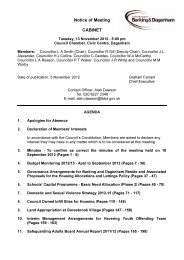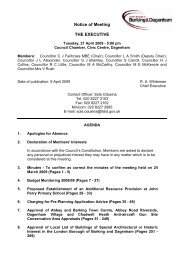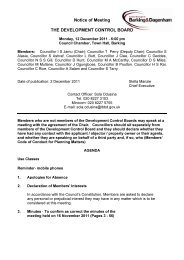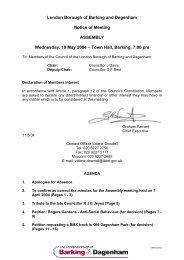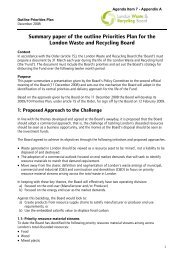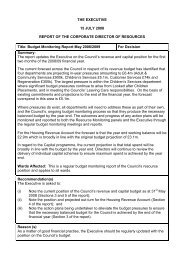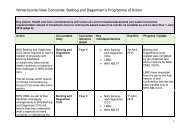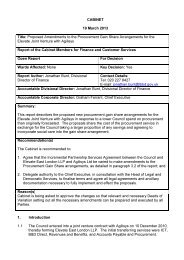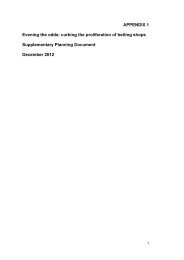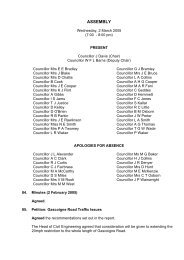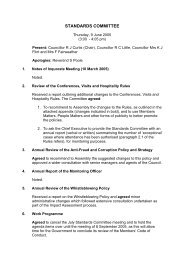Debt Management Performance and Write-Offs 2012/13 (Quarter 4)
Debt Management Performance and Write-Offs 2012/13 (Quarter 4)
Debt Management Performance and Write-Offs 2012/13 (Quarter 4)
Create successful ePaper yourself
Turn your PDF publications into a flip-book with our unique Google optimized e-Paper software.
CABINET<br />
25 June 20<strong>13</strong><br />
Title: <strong>Debt</strong> <strong>Management</strong> <strong>Performance</strong> <strong>and</strong> <strong>Write</strong>-<strong>Offs</strong> <strong>2012</strong>/<strong>13</strong> (<strong>Quarter</strong> 4)<br />
Report of the Cabinet Member for Finance<br />
Open Report<br />
Wards Affected: None<br />
Report Author: Peter Cosgrove,<br />
Operations General Manager<br />
For Information<br />
Key Decision: No<br />
Contact Details:<br />
Tel: 0208 227 3850<br />
E-mail: peter.cosgrove@elevateeastlondon.co.uk<br />
Accountable Divisional Director: Jonathan Bunt, Divisional Director Finance<br />
Accountable Director: Graham Farrant, Chief Executive<br />
Summary<br />
This report sets out the performance of the Council’s joint venture company, Elevate East<br />
London, in carrying out the debt management function on behalf of the Council <strong>and</strong> covers<br />
the last quarter of the year <strong>2012</strong>/<strong>13</strong>. It also includes details of debt written off in<br />
accordance with the write off policy approved by Cabinet on 18 October 2011.<br />
Recommendation(s)<br />
Cabinet is asked to:<br />
(i) Note the contents of this report as it relates to the performance of the debt<br />
management function carried out by the Revenues <strong>and</strong> Benefits service operated<br />
by Elevate East London, including the performance of bailiffs; <strong>and</strong><br />
(ii) Note the debt write-offs for the fourth quarter of <strong>2012</strong>/<strong>13</strong> <strong>and</strong> that a number of these<br />
debts will be publicised in accordance with the policy agreed by Cabinet.<br />
Reason<br />
Assisting in the Council’s Policy aim of ensuring a well run organisation delivering its<br />
statutory duties in the most practical <strong>and</strong> cost-effective way. It will ensure good financial<br />
practice <strong>and</strong> adherence to the Council’s Financial Rules to report on debt management<br />
performance <strong>and</strong> total debt write-off each quarter.<br />
1. Introduction <strong>and</strong> Background<br />
1.1 The Council’s Revenues, Benefits, General Income <strong>and</strong> Rents Service is operated<br />
by the Council’s joint venture company Elevate East London LLP (Elevate). The<br />
service is responsible for the management of the Council’s debt falling due by way<br />
of statutory levies <strong>and</strong> chargeable services.
1.2 This report sets out the performance for the fourth quarter of <strong>2012</strong>/<strong>13</strong> <strong>and</strong> covers<br />
the overall progress of each element of the service for the year. In addition it<br />
summarises the debts that have been agreed for write off in accordance with the<br />
Council’s Financial Rules. <strong>Write</strong> offs in the fourth quarter have been actioned in<br />
accordance with the Council’s debt management policy agreed on 18 October<br />
2011.<br />
2. Proposal <strong>and</strong> Issues<br />
2.1 Set out in table 1 below is the performance for quarter 4 of <strong>2012</strong>/<strong>13</strong> achieved by<br />
Elevate for each of the functions of the Revenues Service during the financial year.<br />
Table 1: Collection Rate <strong>Performance</strong> - <strong>2012</strong>/<strong>13</strong><br />
Type of <strong>Debt</strong><br />
Annual<br />
Target<br />
<strong>Performance</strong> Variance<br />
Actual<br />
collected<br />
£m<br />
Council Tax 94.5% 94.6% +0.1% 49.421<br />
NNDR 97.1% 95.1% -2.0% 53.297<br />
Rent 96.80% 96.95% +0.15% 96.425<br />
Leaseholder<br />
s<br />
General<br />
Income<br />
Council Tax collection performance<br />
86.26% 90.43% +4.54% 3.396<br />
99.62% 99.<strong>13</strong>% -0.49% 77.522<br />
2.2 Council Tax collection at the end of the financial year was 0.1% above the target.<br />
The percentage collection was 94.6%, equating to £49.4m of the £52.3m Council<br />
Tax due for the full year. This continues the trend of improvement since the<br />
inception of Elevate with in-year collection improving by 1.7% since 2010.<br />
2.3 Changes <strong>and</strong> improvements:<br />
i. The number of Council Tax payers paying by direct debit has increased<br />
by 5.3% at the end of quarter 4, taking those paying by direct debit from<br />
26,422 to 27,820 since April <strong>2012</strong>.<br />
ii. A greatly improved recovery schedule has been introduced, ensuring that<br />
residents are quickly <strong>and</strong> effectively informed of any missed payments.<br />
iii. Increased control has been introduced around the selection of the<br />
different methods of debt recovery. Unpaid debts are now screened <strong>and</strong><br />
the most effective <strong>and</strong> secure methods of recovery are selected for each<br />
account.<br />
iv. Procedures have been documented <strong>and</strong> are version controlled to ensure<br />
staff have easy access to the information they need.<br />
v. The payment arrangement policy continues to ensure that those requiring<br />
more time to pay are managed correctly. Those that fail to adhere to the<br />
terms of the arrangement are quickly identified <strong>and</strong> debt recovery action<br />
initiated.<br />
vi. The segmentation of accounts before <strong>and</strong> after bailiff action has been<br />
significantly improved, ensuring that the use of bailiffs is kept to a
minimum <strong>and</strong> resulting in increased use of attachments to earning <strong>and</strong><br />
benefits.<br />
vii. Having carried out quality monitoring of the call centre, the Council Tax<br />
team moved to co-locate with the call centre to concentrate on improving<br />
the quality of telephone responses. Support <strong>and</strong> training is delivered on<br />
an ongoing basis.<br />
NNDR collection performance<br />
2.4 NNDR was not direct income to the Authority in <strong>2012</strong>/<strong>13</strong> <strong>and</strong> was collected on<br />
behalf of central government <strong>and</strong> paid into a central pool. Collection at the end of<br />
the fourth quarter was 95.1% equating to £53.3m of the £56m debt due for the<br />
whole year. This was 2% below target <strong>and</strong> a reduction of 1.3% when compared<br />
with the previous year, <strong>and</strong> reflects an apparent general downward trend in<br />
Business Rate collection across London.<br />
2.5 This deterioration has occurred despite an increase in formal recovery activity, as<br />
shown in the table below:<br />
Year Reminders Summonses Liability Orders<br />
issued to bailiff<br />
2011/12 4,012 849 349<br />
<strong>2012</strong>/<strong>13</strong> 4,509 1,267 438<br />
2.6 The collection rate is below the target for the year <strong>and</strong> has been seriously impacted<br />
by the financial environment in which businesses are operating. As a consequence<br />
of this environment:<br />
i. The challenging economic times have resulted in many businesses<br />
struggling to make payment <strong>and</strong> in some cases having to close with<br />
debts outst<strong>and</strong>ing. In order to avoid this outcome, the service has<br />
concentrated upon being flexible with businesses that are clearly<br />
experiencing difficulty although balancing this with the need to collect<br />
the outst<strong>and</strong>ing debts. Whilst historically there have always been<br />
businesses that have been slow to pay their NNDR, the experience in<br />
<strong>2012</strong>/<strong>13</strong> has shown that even long established businesses with good<br />
payment records have struggled to pay.<br />
ii. The government introduced a scheme in <strong>2012</strong>/<strong>13</strong> allowing business<br />
rates payers the option to defer payment on to 20<strong>13</strong>/14 <strong>and</strong> 2014/15<br />
on an element of the charge related to the annual increase. A total of<br />
£210k has been deferred this year, resulting in a reduction of 0.4% to<br />
the collection rate.<br />
2.7 Elevate management are looking closely at the collection process in this area <strong>and</strong><br />
will continue to implement improvements. These will include improved payment<br />
arrangements, improved selection of cases for debt recovery action <strong>and</strong> improved<br />
inspections of properties by visiting officers to both maintain the Business Rates<br />
register <strong>and</strong> discuss payment issues with businesses. Work in quarter 4 focused<br />
upon identifying businesses that had failed to pay so that contact would be made<br />
earlier to attempt to avoid enforcement action.
2.8 Close working with the Environmental Health Service is being maintained in order to<br />
ensure that any improper use of business properties is minimised. The service<br />
continues to work with Housing Services on potential projects to bring unoccupied<br />
business properties into potential use for Housing services<br />
Rent collection performance<br />
2.9 At year end rent collection achieved was 96.95%, which is 0.15% above the target<br />
performance of 96.80% <strong>and</strong> represents £96.4m of the £99.4m collectable.<br />
2.10 A direct comparison with previous year’s performance is difficult as for <strong>2012</strong>/<strong>13</strong> a<br />
House Mark measure for rent collection has been adopted which is different from<br />
the previously used Rents performance indicator (PI), known as “BV 66a.”<br />
2.11 Exceeding the rent collection target is a consequence of several actions:<br />
i. Making better use of information <strong>and</strong> data to inform management action.<br />
For example, knowing that historically there has been a dip in collection<br />
during the winter months, a payment campaign was launched in<br />
November <strong>2012</strong>. This included having posters displayed showing the<br />
possible impact of non-payment. Officers also visited properties to<br />
deliver pre-printed cards to tenants in arrears which carried messages<br />
informing of the need to clear their rent account in order to avoid further<br />
recovery proceedings.<br />
ii. Other actions included rent statements <strong>and</strong> messages on the on-line<br />
service that reminded tenants to put rent payment first <strong>and</strong> also<br />
highlighted the possible consequence of non payment.<br />
iii. Improved procedures at the sign up of new tenancies to maximise<br />
housing benefit take up from the start of tenancy <strong>and</strong> payment through<br />
Direct Debit.<br />
iv. A review of the interactions between tenants <strong>and</strong> both the rents (Elevate)<br />
<strong>and</strong> Housing <strong>Management</strong> (LBBD) services was undertaken to ensure<br />
that at each contact staff were mindful to provide advice that helped to<br />
prevent arrears. In particular, any potential action relating to eviction that<br />
was not the optimal solution to the Council was avoided.<br />
Leaseholders’ debt collection performance<br />
2.12 Elevate achieved a further significant improvement on Leasehold Service Charges<br />
with a collection rate of 90.80% against the target of 86.26%, an increase of 4.54%.<br />
2.<strong>13</strong> The main area of improvement in respect of leaseholder debt has arisen from a<br />
more proactive engagement with leaseholders who are behind with their payments.<br />
General Income collection performance - Total position<br />
2.14 General Income is used to describe the ancillary sources of income available to the<br />
Council <strong>and</strong> which support the cost of local service provision. Examples of areas<br />
from which the Council derives income include: penalty charge notices; social care<br />
charges; housing benefit overpayments; rechargeable works for housing; nursery<br />
fees; trade refuse; truancy penalty notices; hire of halls <strong>and</strong> football pitches. Oracle
is used for the billing of these debts <strong>and</strong> collection performance by Elevate for its<br />
activities across all these debts is reported together.<br />
2.15 Collection finished the year 0.49% (£383k) below the position achieved at the end<br />
of 2011/12 at 99.<strong>13</strong>%. However, following discussions between the council <strong>and</strong> a<br />
supplier on disputed invoices a payment of £745,483 was received on 22 April<br />
20<strong>13</strong>.<br />
2.16 Major Improvements in General Income collection included revised processes to<br />
ensure that income due from the PCT <strong>and</strong> school salaries were received <strong>and</strong> paid<br />
up to date.<br />
Penalty Charge Notices<br />
2.17 This recovery work only includes debts due to Penalty Charge Notices (PCNs) for<br />
parking, bus lane <strong>and</strong> box junction infringements once a warrant has been obtained<br />
from the Traffic Enforcement Centre (TEC). The majority of these relate to parking<br />
infringements <strong>and</strong> Elevate enforce these warrants through bailiffs <strong>and</strong> monitor their<br />
performance. Overall collection rates on PCNs will be reported by Environmental<br />
<strong>and</strong> Enforcement Services (Parking Services). <strong>Performance</strong> is set out in 2.24<br />
below.<br />
Collection of social (home <strong>and</strong> residential) care charges<br />
2.18 The Council’s Fairer Contribution Policy commenced from October 2011 <strong>and</strong><br />
applies to home care. Residential care charges are covered by the Department of<br />
Health’s Charging for Residential Accommodation Guide (CRAG).<br />
2.19 Collections of debt for home <strong>and</strong> residential care are reported separately.<br />
2.20 For both the agreed measure for performance reporting is the percentage collected<br />
on debt over 120 days old <strong>and</strong> is not particular to a financial year.<br />
2.21 Residential care debt for which the Council has secured the debt with a charging<br />
order against the client’s asset is not included in these figures.<br />
Residential care<br />
Mar<br />
<strong>13</strong><br />
Homecare<br />
Mar<br />
<strong>13</strong><br />
Invoices<br />
Debit<br />
Raised<br />
Total<br />
Collected<br />
Collection<br />
rate Target Difference<br />
120+<br />
days £3,654,859 £3,247,377 88.85% 90% -1.15%<br />
Invoices<br />
Debit<br />
Raised<br />
Total<br />
Collected<br />
Collection<br />
rate Target Difference<br />
120+<br />
days £1,095,788 £936,650 85.48% 90% -4.52%<br />
2.22 The recovery process of these debts is similar to that of other debts, but with added<br />
recognition given to particular circumstances. In order to ensure that the action<br />
taken is appropriate <strong>and</strong> to maximise payments each case is considered on its<br />
merits at each stage of recovery <strong>and</strong> wherever possible payment arrangements are
agreed. In addition a further financial reassessment of a client’s contribution is<br />
undertaken where there is extraordinary expenditure associated with the care of the<br />
service user.<br />
Housing Benefit Overpayments<br />
2.23 For <strong>2012</strong>/<strong>13</strong> a target for collection of £2.648m was set. The target was exceeded<br />
by £524k, with a total of £3.172m collected by the end of March 20<strong>13</strong>.<br />
Bailiff <strong>Performance</strong><br />
2.24 Bailiff action is a key tool for the Council to recover overdue debts but is only one<br />
area of collection work. Members have previously requested information on the<br />
performance of the Bailiffs <strong>and</strong> this is set out in the table below by type of debt for<br />
<strong>2012</strong>/<strong>13</strong>:<br />
Service Value less returns Total remitted Collection rate<br />
Council Tax £4,426k £6<strong>13</strong>k <strong>13</strong>.9%<br />
NNDR £760k £309k 40.6%<br />
General Income £93k £15k 16.3%<br />
Commercial rent £27k £21k 80.4%<br />
Road Traffic £1,171k £185k 15.8%<br />
Note 1 General Income excludes £32k passed to Bailiffs on 28 March 20<strong>13</strong><br />
<strong>Debt</strong> <strong>Write</strong>-off: <strong>Quarter</strong> 4 <strong>2012</strong>/<strong>13</strong><br />
2.25 Any debt recommended for write off is in accordance with the policy of the Council<br />
who have the final decision with regard to write off. The value of debt<br />
recommended for write off for the fourth quarter of <strong>2012</strong>/<strong>13</strong> (January to March 20<strong>13</strong>)<br />
totals: £887,903 (Appendix A). This means the total debt recommended for write off<br />
in 12/<strong>13</strong> was £2.748m (Appendix B) (£2.4m in 2011/12).<br />
2.26 The figures in Appendix B identify a significant increase in the level of write-offs in<br />
Council Tax in <strong>2012</strong>/<strong>13</strong>. This reflects a combination of a number of write-offs<br />
prepared in late 2011/12 but not processed until <strong>2012</strong>/<strong>13</strong>, plus a more systematic<br />
<strong>and</strong> regular approach in <strong>2012</strong>/<strong>13</strong>. The very low level of write-offs in Rents indicates<br />
that this is also needed in that area.
2.27 654 debts were written off in quarter 4 of which:<br />
Absconded/not Uneconomic to <strong>Debt</strong>or Insolvent Other reasons<br />
traced<br />
pursue<br />
19.0% 65.9% 9.6% 5.5%<br />
The Other reasons category includes examples such as: where a debtor is<br />
deceased; the debt is remitted by the court; <strong>and</strong> the debtor is living outside the<br />
jurisdiction of the English Courts <strong>and</strong> is unlikely to return.<br />
Publication of individual details of debts written off (Appendix C)<br />
2.28 In line with Council policy established in 2007 due to the difficulties of finding<br />
absconding debtors, a list showing the details of debtors who have had debts<br />
written off is attached to this report at Appendix C. The list has been limited to the<br />
ten largest debts only <strong>and</strong> can be used in the public domain.<br />
3. Options Appraisal<br />
3.1 This is not relevant for an information report.<br />
4. Consultation<br />
4.1 This is not relevant for this information report.<br />
5. Financial Implications<br />
Implications verified by: Jonathan Bunt, Divisional Director of Finance<br />
5.1 Collecting all sums due to the Council is critical to its ability to function. In view of<br />
this, monitoring performance is a key part of the monthly meetings with Elevate.<br />
5.2 The monthly meetings between Elevate <strong>and</strong> the Council focus on the areas where<br />
the targets are not being achieved <strong>and</strong> discuss other possibilities to improve<br />
collection. An example of this is the need to collect prior to or when a service is<br />
provided, thereby avoiding the need to raise an invoice <strong>and</strong> collect a debt.<br />
5.3 These meetings also ensure that key activities to enable debts to be collected <strong>and</strong><br />
accurately administered are being carried out. A key indicator of this is the<br />
processing of bad debts. At the end of Q4, the total of write-offs at £2.748m<br />
indicates that this is happening.<br />
6. Legal Implications<br />
Implications verified by: Eldred Taylor-Camara, Legal Group Manager<br />
6.1 The pursuit of debts owed to the Council is a fiduciary duty. The Council seeks to<br />
recover money owed to it by the courts once all options are exhausted. Not all debt<br />
will be recovered <strong>and</strong> a pragmatic approach has to be taken with debts as being on<br />
occasions, uneconomical to recover in terms of the cost of process <strong>and</strong> the means<br />
of the debtor to pay. As observed in the body of this report, in the case of rent<br />
arrears, a possession <strong>and</strong> subsequent eviction orders are a discretionary remedy
<strong>and</strong> the courts will on many occasions suspend the possession order on condition<br />
the tenant makes a contribution to their arrears. The Council’s decision to utilise<br />
Introductory Tenancies will over time begin to have an impact as only those tenants<br />
with a satisfactory rent payment history can expect to be offered a secure tenancy.<br />
6.2 The decision to write off debts has been delegated to Chief Officers who must have<br />
regard to the Financial Rules.<br />
7. Other Implications<br />
7.1 Risk <strong>Management</strong> - No specific implications save that of this report acting as an<br />
early warning system to any problems in the area of write off’s.<br />
Background Papers Used in the Preparation of the Report:<br />
• Continuous Service Improvement Plans (CSIPs) for Revenues Service areas.<br />
List of appendices<br />
• Appendix A – <strong>Debt</strong> <strong>Write</strong> Off Table for <strong>Quarter</strong> 4 <strong>2012</strong>/<strong>13</strong>.<br />
• Appendix B – <strong>Debt</strong>s written off in 2011/12 <strong>and</strong> <strong>2012</strong>/<strong>13</strong> totals.<br />
• Appendix C – Ten Largest <strong>Debt</strong>s Written Off in <strong>Quarter</strong> 4, <strong>2012</strong>/<strong>13</strong>



